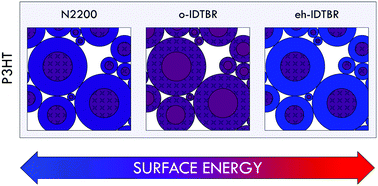Nanomorphology of eco-friendly colloidal inks, relating non-fullerene acceptor surface energy to structure formation†
Abstract
Nanoengineered, eco-friendly, solution-processable electroactive materials are in demand for the growing field of printed electronics, and these material requirements can be achieved by the development of waterborne colloidal dispersions. Functionality in these composite materials can be tuned by thermodynamically modifying the material nanomorphology, often by creation of kinetically stabilized aqueous nanoparticle dispersions. In this work we demonstrate that the internal structure of organic nanoparticles is controlled by the surface energy difference between the polymeric donor material and the non-fullerene acceptor (NFA) material. Nanoparticles of the following donor–acceptor combinations, suitable for printed organic photovoltaics, have been synthesized: TQ1:N2200, TQ1:PNDIT10, P3HT:N2200, P3HT:o-IDTBR and P3HT:eh-IDTBR. Advanced synchrotron-based X-ray spectroscopy and microscopy are used to correlate the formation of core–shell nanoparticle morphology to the material surface energy. We subsequently present a viable avenue for customizing the blended nanoparticle structure into (i) core–shell, (ii) molecularly intermixed, or (iii) inverted shell–core structures. Our results showed that TQ1:PNDIT10 and P3HT:o-IDTBR nanoparticles were comprised of a donor-rich shell and an NFA-rich core, however, interestingly we show a reversal to the inverse NFA shell/donor core structure for TQ1:N2200, P3HT:N2200 and P3HT:eh-IDTBR nanoparticles, driven by the low surface energy of N2200 (23.7 mJ m−2) and eh-IDTBR (18.3 mJ m−2). This article is the first report of a flipped nanoparticle core–shell morphology comprising an NFA-rich shell for the miniemulsion synthesis route. The composition of the shells and cores was able to be controlled by the differential mismatch in the surface energy of the donor and acceptor materials, with ΔGsurface > 0, ΔGsurface = 0, and ΔGsurface < 0 for acceptor core–donor shell, molecularly intermixed, and acceptor shell–donor core, respectively. Accordingly, we introduce an entirely overlooked new figure of merit (FoM) for customizing nanoparticulate colloidal inks: tunable surface energy of non-fullerene-based semiconductors. The establishment of this FoM opens up electroactive material design to a wide range of functional printing applications with varying device and ink structure requirements, thereby reshaping the nanoengineering toolkit for waterborne colloidal dispersions and hence printed electronics.



 Please wait while we load your content...
Please wait while we load your content...